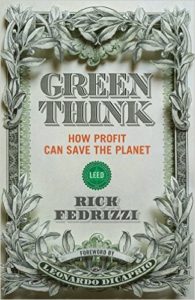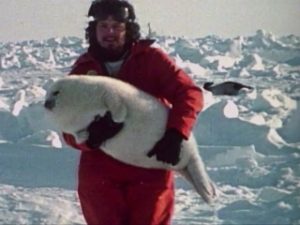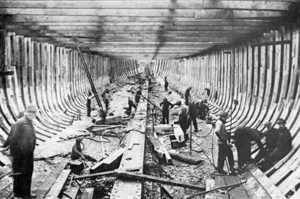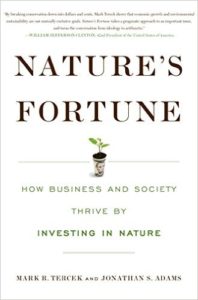“Green Think” – 1

 Before getting to new posting material, I need to update/revise my post about the air above.
Before getting to new posting material, I need to update/revise my post about the air above.
Turns out the U.S. EPA disagrees with the MD Department of the Environment about progress in meeting federal guidelines for air pollutants such as ground-level ozone and NO2. According to Josh Hicks’s recent Washington Post piece: “…large swaths of northern Anne Arundel County and southern Baltimore counties exceed federal limits on sulfur dioxide.” Sulfur dioxide is a precursor to fine-particle pollution.
The bad-boy source for this high level of air pollution right over my office (cough) is the Herbert A. Wagner coal power plant. Located on the Patapsco River in northern Anne Arundel County, the EPA claims Wagner is one of the largest single sources of air pollution on the East Coast.
If the EPA’s preliminary ruling is upheld in its final report due July 2, the state will have to undertake additional measures to come into compliance.
♣
 I’ve been reading and learning from Rick Fedrizzi’s 2015 book, Green Think: How Profit Can Save The Planet.
I’ve been reading and learning from Rick Fedrizzi’s 2015 book, Green Think: How Profit Can Save The Planet.
Some of you know that Fedrizzi is one of the co-founders of the game-changing U.S. Green Building Council back in 1993. He’s been its CEO for years, but is now stepping down at year’s end. (An incoming CEO has already been named.)
 Chapter 4 of Fedrizzi’s book is titled “Eco-nomics.” He opens with what he calls possibly the oldest corporate mission statement, that from a ryokan (a small, traditional Japanese inn): “Take care of fire, learn from water, cooperate with nature.”
Chapter 4 of Fedrizzi’s book is titled “Eco-nomics.” He opens with what he calls possibly the oldest corporate mission statement, that from a ryokan (a small, traditional Japanese inn): “Take care of fire, learn from water, cooperate with nature.”
He goes on to quote well known economics theorist Adam Smith: “The things which have the greatest value in use have frequently little or no value in exchange.” (You remember this ole chestnut, right?)
Further: “Nothing is more useful than water: but it will purchase scarce anything; scarce anything can be had in exchange for it.”
Having set the stage a bit, Fedrizzi begins to make his own point that “what economies value instead is nature transformed [italics his].” He cites raw commodities from nature, such as natural gas out of a well in the ground and grapes from a vine as being prime for transformation, i.e., electricity and chardonnay. The extension of these examples is that wealth is created by transformation which, of course, is the very opposite of conservation.
Targeting the all-important timber industry of the later 1800s, Fedrizzi quotes Philip Shabecoff’s book, A Fierce Green Fire: “Soil erosion, loss of watersheds, and disappearance of game had by the latter part of the nineteenth century become national problems as the once seemingly endless forests were methodically leveled.”  (Shabekoff’s book was turned into a 2013 movie which Rotten Tomatoes’ Audience scored 68%.)
(Shabekoff’s book was turned into a 2013 movie which Rotten Tomatoes’ Audience scored 68%.)
 Of course the timber industry spawned the construction of ships, mills, pianos, railroad ties, homes and factories and a plethora of other products necessary to further human productivity, safety and comfort.
Of course the timber industry spawned the construction of ships, mills, pianos, railroad ties, homes and factories and a plethora of other products necessary to further human productivity, safety and comfort.
The sacrifice of this very major natural resource gave rise to the likes of John Muir and the Romantic Movement. He and many others called for the creation of national parks. Pioneering land surveyors such as Verplanck Colvin, and the likes of photographer Seneca Ray Stoddard and painters such as Thomas Cole were instrumental in depicting natural landscapes which in turn pressed politicians into agreeing to the creation of the 9.4M-acre Adirondack Park in New York State in 1892, and many others across our land.
 Fedrizzi then introduces his readers to Mark Tercek, a former Goldman Sachs exec who now heads the Nature Conservancy. Tercek advances the notion that “nature has value independent of transformation” in his book Nature’s Fortune: How Business and Society Thrive By Investing in Nature. He observes: “For generations, economists assumed that manufacturers could run down natural capital as much as they wanted, so long as the economy overall created enough man-made capital to replace it.”
Fedrizzi then introduces his readers to Mark Tercek, a former Goldman Sachs exec who now heads the Nature Conservancy. Tercek advances the notion that “nature has value independent of transformation” in his book Nature’s Fortune: How Business and Society Thrive By Investing in Nature. He observes: “For generations, economists assumed that manufacturers could run down natural capital as much as they wanted, so long as the economy overall created enough man-made capital to replace it.”
“When the scale of economic activity remained small in comparison to the scale of the planet itself, this may have been a workable assumption–but not anymore,” Tercek exclaims.
Of course Smith’s theory was based on natural resources in abundance back in the day. Since then, Fedrizzi says: “population picked up…humans began to lead longer, healthier lives.” In 1804, he states, the world’s population hit 1B. By 1927, it was 2B. By 1974 it was 4B. By 2011, more than 7B. Another 1B is forecasted over the next +8 years.
Consumption has followed this trajectory and so, obviously, has natural resources depletion, fouling and eradication.
That’s you and me–us–isn’t it?
P.S. Tim de Chant, of the Global Footprint Network, offers that if all the world’s people lived like Americans, we’d need more than four Earth’s worth of land to sustain ourselves.
You gotta see his Per Square Mile infographic here!